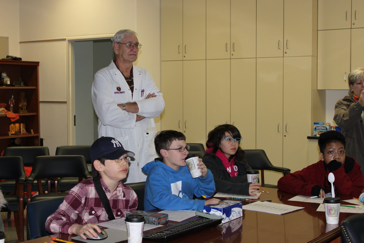
DoDEA Pacific Public Affairs
Unit 35007
APO, AP 96376
DSN: 315-544-5657
From the States: 011-81-6117-55-5657
PublicAffairs@pac.dodea.edu
The DoDEA Pacific Public Affairs Office initiates and manages DoDEA's communications and outreach efforts for the Pacific to include Guam, Japan, Okinawa, South Korea. The office is responsible for media relations, internal information programs and communication with students, parents, teachers, school administrators and the public.
TOKYO, JAPAN — February 15, 2012 — Sixth graders at Department of Defense Education Activity Pacific’s Yokota Middle School traded pillows for planetary exploration at 4:30 a.m. Japan Standard Time on Jan. 31.
Their mission was to take control of the Goldstone Apple Valley Radio Telescope (GAVRT) for two hours and record data from Jupiter as part of a Jupiter Quest Challenge. The Jupiter Quest Challenge is a broad-based, interdisciplinary curriculum unit that promotes critical and creative thinking through the study of Jupiter and the Jovian System. For the challenge, students applied research principles they learned in class to separate lessons relating to Jupiter and the basics of radio astronomy. At the end of the instructional unit, students were offered the opportunity to collaborate with the Lewis Center for Educational Research in Apple Valley, Calif. As a testament to their shared commitment to scholarship and discovery, students and a few teachers gave up sleep to take control of the GAVRT. They worked as a team to collect and recorded thermal and non-thermal radio emissions from the Jovian system. The data collected by the students was recorded for use by National Aeronautics and Space Administration scientists, universities and other organizations that conduct space research.
The project was a perfect match with a renewed effort to improve science, technology, engineering and mathematics—commonly referred to as STEM—instruction in schools across DoDEA. “Projects like GAVRT encourage students interested in STEM by providing unique, hands-on experiences that make real contributions to the field of science,” explained Katie Beyer-Rodgers, a gifted resource specialist at Yokota Middle School, “The students were able to apply what they learned [in class] about the basics of radio astronomy to real word situations.”
The GAVRT Program—together with the support and participation of NASA and their Jet Propulsion Lab scientists and engineers, as well as Mission Control Operators from the Lewis Center for Educational Research—enables students to participate in compelling, real-time experiences and ongoing missions. More importantly, the projects bring deeper meaning to the STEM skills they have been developing in the classroom as they are challenged to apply their knowledge to real-life situations.
The students were excited to be a part of the research and said they look forward to participating in additional projects focusing on the study of Jupiter and its moons.
“The best part of the research for me was finding out what the necessary components of spacecraft are for travel to outer space,” said sixth-grader Sadie Salmon, “It was challenging to take all the group’s research and make sense of it.”
To learn more about the Goldstone Apple Valley Radio Telescope visit The Lewis Center GAVRT Page.
 |
TOKYO (Jan. 31, 2012) Science Teacher, Skip Myrick, observes sixth grade students from Yokota Middle School as they observe the GAVRT radio telescope. The students worked with staff at the Lewis Center for Educational Research in Apple Valley, Calif., for two hours to record temperatures on Jupiter’s atmosphere. |
 |
TOKYO (Jan. 31, 2012) Sixth grade students from Yokota Middle School anxiously call sighting numbers off to find Jupiter’s peak. The students worked with staff at the Lewis Center for Educational Research in Apple Valley, Calif., for two hours to record temperatures on Jupiter’s atmosphere. |
About DoDEA Pacific:
DoDEA Pacific provides a comprehensive preK-12 education to the children of military and eligible civilian personnel families serving throughout Asia. The 49 schools in DoDEA Pacific are comprised of more than 24,000 students and 3,100 full-time professional educators and support staff. The schools are geographically organized into four districts: Guam, Japan, Okinawa and South Korea.
Visit us on FaceBook!